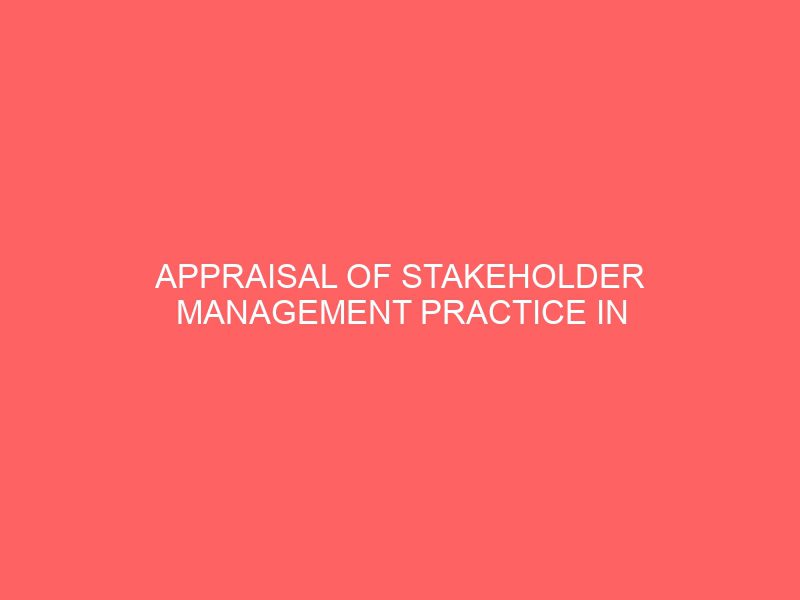Description
ABSTRACT
Several researchers have identified the importance of managing stakeholders as major criteria for determining project success Project success has now extended beyond completing projects within budgets, schedule and set standards as traditionally viewed Satisfying key stakeholders is another criteria used in evaluating project success, thus stakeholder management is an important aspect of project management In Nigeria, studies conducted in the research area have not assessed the adoption of stakeholder management Therefore, this study appraises the concept in TETFUND construction projects Interviews were conducted with project managers that have managed TETFUND construction projects in higher institutions Comparative content analysis was used for analysing the interview responses The results show the level of awareness and application of the concept within the firms; communication identified as the major tool for managing project stakeholders; and the major barriers encountered in managing stakeholders Despite the awareness and acknowledgements of the importance of managing stakeholders, there is no proper adoption of the guidelines for stakeholder management as stated in literature The study recommends that proper adoption of stakeholder analysis and engagement steps should be embraced by consulting project management firms in managing project stakeholders.
CHAPTER ONE
INTRODUCTION
1.1 Background to the study
The development of every country directly depends on its construction as it provides fixed assets and serves as a major aspect of production to other sectors of the economy. The construction industry helps in providing infrastructures that improve the life of its citizens. The Nigerian Construction Industry NCI is not an exception as it contributes to the nations economy. Yet, the NCI is coupled with challenges in terms of servicing and satisfying its clients needs Kolo and Ibrahim, 2010. Ajayi et al. 2010 attributed disagreement among participating parties as one of the reasons for project failure in Nigeria while Onarinde 2011 further pointed out that the Nigerian Construction Industry NCI has not fully been able to embrace the vast importance of managing stakeholders involved in projects. This could be as a result of its complex nature, size and other challenges that it is facing in satisfying its customers.
The importance and role of the industry to other sectors of the economy makes it to have different stakeholders with wide range of interests that need to be managed. According to Farinde and Sillars 2012, the construction industry is a complex and huge industry with several key players with different interests. Therefore, a project can be successful in its entirety when the construction organisation is able to effectively manage all human and nonhuman resources; this is done in order to deliver a facility that satisfies and exceeds the needs of the client at the time it is required and within considerable budget range.
TABLE OF CONTENTS
DECLARATION ii
CERTIFICATION iii
DEDICATION iv
ACKNOWLEDGEMENT v
ABSTRACT vi
LIST OF TABLES x
LIST OF FIGURES xi
GLOSSARY OF ABBREVIATIONS xii
CHAPTER ONE 1
INTRODUCTION 1
11 Background to the study 1
12 Statement of research problem 4
13 Need for the study 5
14 Aim and objectives 5
141 Aim 5
142 Objectives 5
15 Scope and limitations 6
151 Scope 6
152 Limitations 6
CHAPTER TWO 7
LITERATURE REVIEW 7
21 The Nigerian Construction Industry 7
22 Project success 8
22 Tertiary Education Trust Fund TETFUND 10
24 Project stakeholders 11
241 Definition 12
242 Classification 15
25 Stakeholder management 17
251 Stakeholder theory 18
viii
26 Stakeholder analysis and engagement processes 19
261 Stakeholder identification 20
262 Prioritising 23
263 Mapping 25
264 Engaging 28
265 Managing 28
27 Challenges facing stakeholder analysis 32
28 Critical success factors CSF for stakeholder management 33
29 Importance of stakeholder management 34
210 Theoretical framework for stakeholder management practice 35
CHAPTER THREE 37
RESEARCH METHOD 37
31 Research design 37
32 Research method 37
33 Research approach 38
34 Research instruments 39
35 Population of the study 40
36 Sampling technique 41
37 Data collection 42
38 Data analysis 43
39 Framework for the research 43
CHAPTER FOUR 45
DATA ANALYSIS, PRESENTATION AND DISCUSSIONS 45
41 Data analysis and presentation 45
411 Characteristics of the interviewees 45
412 Respondents understanding of Stakeholder management practice 46
413 Stakeholder analysis 48
414 Engagement of Stakeholders 48
415 Barriers/challenges in Managing Stakeholders 51
42 Discussions of results 52
ix
CHAPTER FIVE 63
SUMMARY, CONCLUSION AND RECOMMENDATION 63
51 Summary of findings 63
5 2 Conclusion 64
53 Recommendations 64
REFERENCES 66
APPENDIX 75
LIST OF TABLES
Table 21: Summary of classification of stakeholders 16
Table 22: Methods for identifying stakeholders 21
Table 23: Directions of influence in identifying stakeholders 23
Table 24: Theoretical Framework for the Research 36
Table 31: Northwestern Nigerian States and their tertiary institutions41
Table 41: Respondents Details45
Table 42: Definitions obtained in the Field Survey47








Reviews
There are no reviews yet.